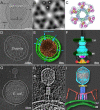Minicells, Back in Fashion
- PMID: 26833418
- PMCID: PMC4859596
- DOI: 10.1128/JB.00901-15
Minicells, Back in Fashion
Abstract
Cryo-electron tomography (cryo-ET) has emerged as a leading technique for three-dimensional visualization of large macromolecular complexes and their conformational changes in their native cellular environment. However, the resolution and potential applications of cryo-ET are fundamentally limited by specimen thickness, preventing high-resolution in situ visualization of macromolecular structures in many bacteria (such as Escherichia coli and Salmonella enterica). Minicells, which were discovered nearly 50 years ago, have recently been exploited as model systems to visualize molecular machines in situ, due to their smaller size and other unique properties. In this review, we discuss strategies for producing minicells and highlight their use in the study of chemotactic signaling, protein secretion, and DNA translocation. In combination with powerful genetic tools and advanced imaging techniques, minicells provide a springboard for in-depth structural studies of bacterial macromolecular complexes in situ and therefore offer a unique approach for gaining novel structural insights into many important processes in microbiology.
Copyright © 2016, American Society for Microbiology. All Rights Reserved.
Figures



References
Publication types
MeSH terms
Substances
Grants and funding
LinkOut - more resources
Full Text Sources
Other Literature Sources

